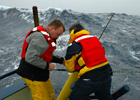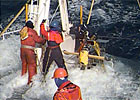Technology
Understanding how marine mammals behave in their environment is difficult. They live throughout the ocean, move constantly, and often are elusive. Sperm whales, for example, spend about 95 percent of their time beneath the waves. Technology helps researchers overcome some of these challenges to learn more about marine life and the ocean. Among the technological advancements developed at Woods Hole Oceanographic are:
- Non-invasive tags to measure stimulus and behavior relations and long term habitat use patterns
- Passive monitoring of marine mammal sounds for location, distribution, behavior monitoring
- Gliders, AUVs, Drifters, Buoys
- Ocean acoustic propagation modeling
- Measurement and modeling of sound reception and auditory processing
- Real-time behavior monitoring
- Methods to reduce risk of ship-whale collision and entanglement of marine mammals in fishing gear
- Scientific animation/visualization
Related Websites

Autonomous Systems Laboratory (ASL)
The ASL research program emphasizes exploratory ocean measurements using contemporary tools and techniques. ASL uses autonomous systems to describe and quantify oceanic processes which occur on time and space scales inaccessible with traditional methods.

Marine Mammal Behavior Laboratory
The Marine Mammal Behavior Laboratory works with marine mammals at sea using visual observation and acoustic recordings and tags to monitor behavior.

Ocean Acoustics Lab (OAL)
Research concentrates on the use of acoustics to measure ocean properties, temperature, and to detect biological and geological objects in the ocean.

